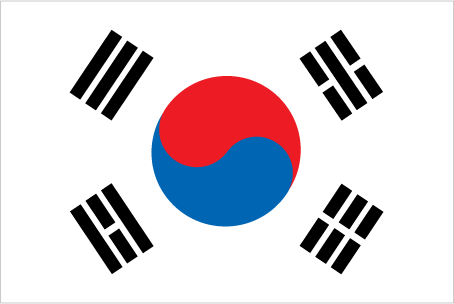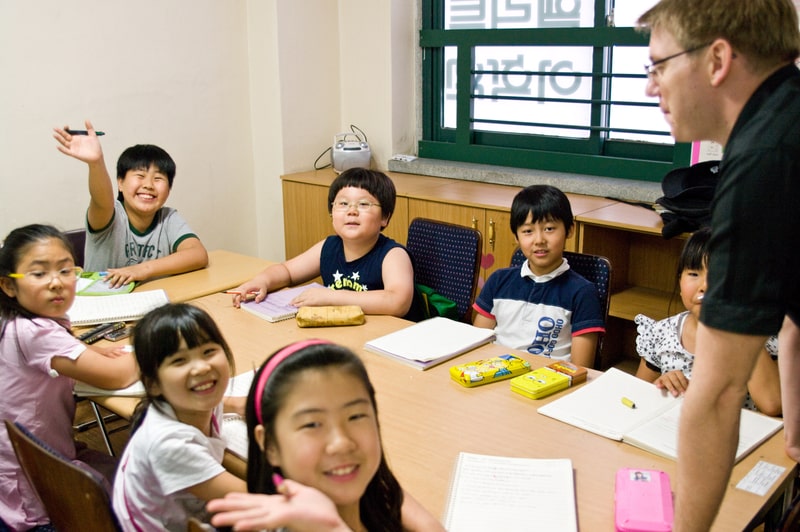Last updated on April 15th, 2022
49. While there is nothing wrong with eating, you are likely to be presented with a number of small plates that may leave you confused. However, the food is healthy and delicious if you are interested in trying new things.
50. Before the partitioning, South Korea and North Korea was one country. However, due to constant political conflicts, the split of Korea became inevitable in the year 1945.
51. The fact that the Soviet Union and the Republic of China could not agree on the implementation of Joint Trusteeship over Korea is one of the reasons why the partitioning of the two countries become very necessary.
52. South Koreans have two legends that they believe played a significant role in bringing salvation to them. They refer to them as the Dangun or the Tangun. The other one is supported by the Chinese texts, which states that Kija led the band of his followers to save the Koreans.
Flag of South Korea

Facts about South Korea for kids
53. South Korea makes the list of one of the biggest economies in the continent of Asia. What this simply implies is that it is okay to compare South Korea with other Big economies such as Hong Kong, Taiwan, and Singapore.
54. The Lotte World Tower found in Seoul is the highest in the country and also ranks fifth in the world.
55. The urban area of the country harbors most of the Koreans, almost 82% of their total population. The country’s population is equal to 0.67% of the world’s total population.
56. South Koreans celebrate the new year twice. They celebrate the New Year at the start of the solar calendar (January 1), as Westerners do and once more on the first day of the year on the lunar calendar. The lunar Korean New Year is a three-day holiday to return home and visit extended family, along with performing ceremonies to honor your ancestors.
57. Numerous endangered species in South Korea need to be saved before they get extinct. Such animals include the Amur leopard, the Siberian tiger, the golden eagle, and the musk deer.
Facts about the culture of South Korea

Family Structure
The family structure is essential as far as the Korean culture is concerned. The Korean people believe in a hierarchical structure, meaning that parents are the head of the family, and therefore children should respect them. Additionally, the young are generally supposed to show respect to the elderly. Due to these family settings, the Koreans believe that loyalty, honor, duty, and sincerity are critical virtues that should be observed by all members of society.
Religion
Buddhism, Confucianism, and Christianity are the dominant religion division that dominates in South Korea. The political struggles between the two countries are responsible for great divergence in the realm of religion. In other words, North Korea is considered a secular country, while South Korea is dominated by both Buddhism and Christianity.
Celebrations
Like in most countries of the world, celebrations pose great importance in the lifestyle of most South Koreans. If you have had a chance to attend any of the celebrations in South Korea, then you will agree that different colors dominate different celebrations. Most celebrations are carried out to celebrate harvests and families. The South Koreans spend most of their time to pray for good harvests since it is one of the major sources for livelihood.
Meals
Two main things will make people enjoy their country of visit. The first one is the beauty of the land, and the other one is the quality of the meals. A country that has diversified meals will be a soft spot for many. When you visit South Korea, you should expect rice, meat and vegetables, and noodles. Also, the Korean table manners that you may need to familiarize yourself with include eating at the same pace as others, guests to say “jal meokkessumnida,” which means that he/she will enjoy the meals as a respect to the host.
The Language
Korean is the official language in both Southern and Northern Korea. Despite the difference in the dialects in the two countries, the two speakers can understand each other much easier.
Facts about people of South Korea
No Personal Space
In some countries, especially the western countries, failing to observe personal space can easily put you into serious problems with the person that you are trying to interact with. However, in South Korea, things are a bit different because personal space is a word that is not common.
Gifts are Highly Appreciated
Another essential thing that you need to understand about the Korean population is that they value gifts highly. So if you want to make new friends in the country, then you should consider buying gifts for the people that you are interested in. Additionally, buying gifts to the people of Korea is considered showing respect and also being courteous. One more critical point to take home is that gifts are given with two hands and gifts are not opened in the presence of the giver.
Tipping Isn’t Necessary
If you have been to America or other western countries, tipping is a common practice, and people there highly appreciate it. However, in Korea, people do not expect, and that is one of the weird facts about South Korea. This, however, does not mean that giving a tip is wrong because some people will take it with both hands and thank you graciously.
The Korean People Love to Travel
It is this fact that has contributed to many people in the land desiring to travel around the country because they know that they are likely to face minimal travel challenges. What this simply means is that you will never get a hard time when it comes to traveling in the country.
They do not Mind Shouting
Although shouting is not a good trait, especially when you are in a foreign land, it appears as the Korean people do not mind it. If you walk into a restaurant and you observe a client shouting at his or her server, you do not have to wonder because this is common here.
Facts about the geography of South Korea
Location
South Korea is located in the east of Asia. North Korea borders the country to the North, Sea of Japan to the east, China to the south, and the west yellow sea. South Korea forms up to 45 percent of the Peninsula’s land.
Land Relief
South Korea is largely mountainous, and this makes the best destination for those people who love climbing mountains. The most important of all is the Sobaek Mountains.
The Drainage
When it comes to matters to do with drainage, South Korea has three main rivers. They include; the Han, Naktong, and the Kum. The three rivers flow between the ranges before entering the low land plains. The interesting thing with the rivers in South Korea is that nearly all of them flow southwards or west words.
Soils
The type of soil that a country has will always influence the success of the country regarding agricultural success. Granite and gneiss are the main type of soil that you will find in South Korea. One common characteristic of this type of soil is that they have less humus content. Additionally, the greatest ash-gray forest soils are found in the highland. If you are planning to cultivate in the land, then you can start figuring out the best type of crops for such soils.
The Climate
Before traveling into a foreign country, one of the things that people tend to consider is the climate. The fact that South Korea is close to Asian landmass means that you should expect summer-winter kind of temperatures. Seasonal windows are also common.
Famous tourist destinations in South Korea
Upo Marsh is one of the best places that you can visit if you want to tour South Korea. One interesting fact about this destination is that it is the largest riverine wetland in Korea. There are more than 3,300 officially affirmed islands off the coast of South Korea.
Ggotji Beach can be the best destination for those people who want to enjoy the sweet conditions of the beach. It is the ideal beach for people to drive while watching as the sun sink.
Darangee Village is a small but well-preserved village that you can only find in South Korea. If you want to know more about the culture of South Korea, then this is the best place to visit.
South Koreans fear death by an electric fan as it is one of the common causes of death in the country. However, according to some sources, it is also believed that “death by fan” is a myth and was even propagated by the South Korean government to curb the use of electricity during the 1970s energy crisis.
South Korea – Country at a glance
| Independence | 15 August 1945 (from Japan) |
|---|---|
| Capital City | Seoul 37°33′N 126°58′E |
| Largest City | Seoul 37°33′N 126°58′E |
| Area | total: 99,720 sq km land: 96,920 sq km water: 2,800 sq km (slightly smaller than Pennsylvania; slightly larger than Indiana) |
| Population | 51,844,834 (2022 est.) |
| Official Language | Korean Korean Sign Language |
| Literacy | 98% (2019) |
| Borders | total: 237 km border countries (1): North Korea 237 km |
| Currency | South Korean won (KRW) |
| Suffrage | 19 years of age; universal |
| Demonym | South Korean Korean |
| Life expectancy | 82.97 years (2022 est.) |
| Climate | temperate, with rainfall heavier in summer than winter; cold winters |
| Terrain | mostly hills and mountains; wide coastal plains in west and south |
| Mean elevation | 282 m |
| Lowest point | Sea of Japan 0 m |
| Highest point | Halla-san 1,950 m |
| National anthem | "Aegukga" (Patriotic Song) |
| Government type | presidential republic |
| President | Yoon Suk-yeol |
| Prime Minister | Han Duck-soo |
| National colors | red, white, blue, black |
| National symbol | taegeuk (yin yang symbol), Hibiscus syriacus (Rose of Sharon) |
| Natural resources | coal, tungsten, graphite, molybdenum, lead, hydropower potential |
| Agricultural land | 18.1% |
| Birth rate | 6.92 births/1,000 population (2022 est.) |
| Death rate | 7.12 deaths/1,000 population (2022 est.) |
| Sex ratio | 1.01 male(s)/female (2022 est.) |
| Industries | electronics, telecommunications, automobile production, chemicals, shipbuilding, steel |
| Exports | $606.71 billion (2020 est.) integrated circuits, cars and vehicle parts, refined petroleum, ships, office machinery (2019) |
| Imports | $540.96 billion (2020 est.) crude petroleum, integrated circuits, natural gas, refined petroleum, coal (2019) |
| GDP - per capita (PPP) | $42,300 (2020 est.) |
| Time Zone | Korea Standard Time (UTC+9) |
| Internet country code | .kr |
| Drives on the | right |
| Calling Code | +82 |
| Table last updated | July 30, 2022 |
